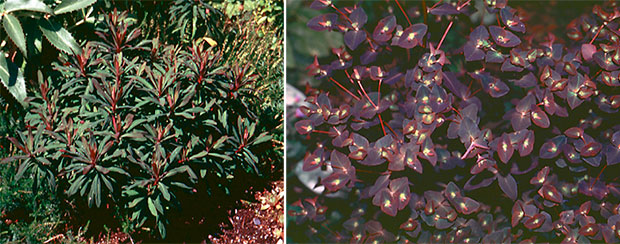
Right: Purple wood spurge (Euphorbia amygdaloides ‘Purpurea’)
by George Papadelis
While English gardeners have prized the merits of cushion spurge (euphorbia) for several years, most American (Michigan) landscapes have yet to benefit from their striking foliage, form, and flowers. Besides poinsettias, the most common American euphorbia is E. polychroma (also called E. epithymoides) whose bright yellow flower bracts in May are followed by an attractive 15-inch clump of pale green foliage. However, several exciting perennial varieties of euphorbias have become more readily available. For a truly stunning display from spring until fall try purple wood spurge (E. amygdaloides ‘Purpurea’). The purple-red new growth is followed by deep green leaves held on sturdy 15-inch stems providing the excellent form for which this genus is so well known. Clusters of chartreuse flowers in spring are an attractive contrast to the foliage. A light winter mulch is recommended but this easy-to-grow plant will tolerate a poor soil and prefers full or partial sun.
For similar striking foliage in your perennial border, E. griffithii ‘Fireglow’ has a much larger growth habit. The pinkish-purple young growth is followed by fiery orange flower bracts in May and June. Sturdy stems support this tidy clump until fall when the foliage ripens to hues of yellow and red. This hardier euphorbia has similar cultural requirements as the aforementioned varieties, but prefers more moisture.
For rock gardens or stone walls, donkey tail spurge (E. myrsinites) is an interesting, low-spreading plant. Stems covered with blue-gray leaves produce contrasting sulfur-yellow flower bracts only 6-inches tall in late spring. Unlike most other euphorbias, this variety tends to be short-lived, but is really worth its life span.
Another euphorbia unjustly underused is an old fashioned annual referred to as snow-on-the-mountain E. marginata. Grown for its showy foliage, lower leaves are a glossy green while upper leaves are white margined. This foliage combines beautifully with brightly colored annuals or can be used as an interesting cut flower. Try the more compact variety ‘Summer Icicle’ which only grows 24-inches tall.
Whether it’s annual or perennial, common or rare, euphorbias deserve a place in your border or rock garden. Please keep in mind that many euphorbias produce a sticky sap that can cause skin irritation.
George Papadelis is the owner of Telly’s Greenhouse in Troy, Shelby Township, and Pontiac, MI.
